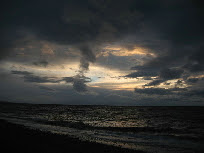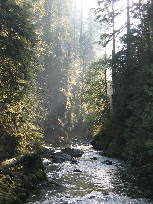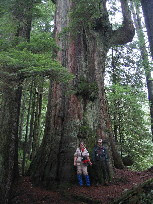Has anyone else been here before?
Photos
http://www.mountbakerclub.org/mtskihistBruce Fairley "A Guide To Climbing and Hiking In Southwestern British Columbia" claims the highest peak in the lower BC mainland to be Skihist (9750'). It is certainly the highest point of anything you could reasonably reach north of the border on a long weekend from Bellingham. www.bivouac.com lists Skihist as the 7th most significant peak in BC. This was enough reason for Bud Hardwick and I (Paul Cookson) to place it on our task list for the summer. We had very little information to go by since few people have ever climbed this peak and we were not certain the road would be driveable after the winter floods. Bud had located the start of the Eagle Ridge route last autumn, fully knowing that the road had a high chance of being closed too far away due to washouts.
Skihist is reached by driving through Hope, crossing the Fraser River bridge at Boston Bar and continuing north for at least an hour to the Kwoiek Creek forest service road heading west. The original route was much shorter, with a direct bushwhack line up to Antimony Lake from the mainline; but a bridge had already been removed, making it impossible to safely cross the creek. The creek was more like a river during this trip, flooding some of the trees along the banks. The raging torrent created such a roar that we drove right up to a young bear without being noticed for a few minutes. The alternate approach for us was making a turn at the 6.5 mile spur and following Eagle Ridge for about 9 miles or so to Antimony Lake. The mainline was passable with Bud's 4x4 truck, only by the help of a dozer that had recently been through to clear the large boulders covering the road every winter. We had stopped by the Hope visitor center where a very helpful young lady phoned the Merritt Forest Service office to confirm we could drive up this drainage. Having found the short spur road up to the Eagle Ridge route, we drove through alders overtaking the road and stopped about a half-mile up the road where a tree had fallen in the way. There was a pile of fresh bear dung and a swarm of nasty mosquitos and flies. So we quickly left the truck and walked about 5 minutes until we located some flagging around a small tree trunk. From there we immediately lost the old boot track and went almost straight up about 800 feet to the ridge line in the heat of the afternoon. Although we had left Bellingham around 7am, the slow road had kept us from departing the truck until 2pm. Once on the ridge, the gps said we only had 7 miles to Antimony Lake in a straight line. Unfortunately, there was very little sign of the abandoned trail and most of the route is now a cross-country ridge walk through waste high brush and severe blowdown from a forest fire. It is easy to stay on the route as long as you always head for the highest point on the ridge. Mosquitos took full advantage all the way to camp, never allowing for a peaceful sit down break. Even though we moved steadily through the brush, our gps was indicating that we were moving at a swift 1 mile per hour. It was not until around 7pm that we finally crossed a small stream to refill our bottles. From this point, around 6200', we began to make use of a few snow patches over the brush and quickly broke out of the trees to the alpine. Then we continued along a rolling ridge to about 7300' where we gave up for the day around 9pm.
Antimony Lake was only 2 miles away in a straight line, but required a winding up and down ridge route, a 1000' descent and a regain of a few hundred feet to the Lake. With a fresh light breeze (our bug repellent) at our high point camp on the ridge, we saw no reason to arrive at the lake in the dark with even more mosquitos waiting. Our view was from Mt Baker to the south, Garibaldi Park to the west and Skihist to the north. I could not think of a better place to wake up early in the morning. It looked like at least another party or two had done the same some time ago. We only had enough water to reach Antimony Lake, so we snacked on some cold food and retired for the night, Bud in his bivy and myself in a one person Eureka tent. Apparently, Bud did not receive very much sleep as the mosquitos were still attacking through the headnet over his bivy. I did not wake up for at least 6 hours in the tent.
We were out of the camp by 6am and did our route over to the lake where we arrived at 7:30am. The guidebook said we would have a trail by this point, but it did not exist. The first half of the high route from camp was straightforward-keep to the ridge and traverse high to avoid a steepening south-facing gully. Once we ran out of ridge, we worked down the steep fall line into boulders, thick trees and more brush. We found a convenient place to cross Antimony Creek and soon found a track on the other side which led to Antimony Lake. There was little sign of campsites here. Our plan was to cook the previous nights dinner and then do the same with this night's dinner after returning from the climb. So we had carried over the stove, fuel, pot and all of our food.
With renewed energy and full water bottles, we took our boots off and crossed the icy-cold outlet of the lake to follow the east shoreline across a 1/2-mile long boulder field. From the head of the lake, we were able to go steeply up a narrow rib on a goat trail to snow fields that continued most of the way to the most obvious 8200' col. We finally broke free of the mosquitos somewhere in this stretch. The snow walking was wonderful on the feet, and only a little uncomfortably steep during the final 200 feet.
Once we were at the col between Clampost and Antimony Mtn, we read our guidebook description that says the route followed the ridge all the way to Skihist. That way looked impossibly long and difficult for a one day return. It was supposed to be a class 3 scramble but looked more like class 5 in places. Before giving up, we located a narrow gully leading down to a high basin about 400 feet below us. From there it looked like we would just need to walk another mile and 2000' up on talus to the top. So we cached the 50' scramble rope and slowly worked our way down the gully, traversed over to the base of the summit scramble and made it up to the peak around 2pm. Surprisingly, the last 2000' were the easiest, as we made steady progress among the boulders and scree which were free of bugs and brush. We considered this approach to be more of a class 2 climb. The temperature was still t-shirt weather on the summit since there was little to no wind. We both felt the lower oxygen levels. There were two summit registers. The first was a film canister with one person who had been up in 2006, but the paper was soaked and too hard to read. The other register was a pvc pipe with threaded cap and only had one party signing in, Greg Jones and Don Funk in 2000. Those pages were wet two. So we dried out the film canister and added our victory page to it; then placed the film register inside the larger canister. As far as we could tell, we were the third party to summit this century. This was no surprise due to the remoteness and difficulty of accessing the peak itself. Views and the uniqueness of being on the highest point in southwestern BC made it worthwhile. We could clearly see into the icefields of Garibaldi Provincial Park and thousands of peaks and ridges far away.
Our only regret was that our turn around time only allowed us to remain on the summit for about a half hour. Camp was very far away. Our descent was made a little easier with the assistance of a snowfield off the south ridge. Although, it was dangerously steep, the snow had softened just enough to slide down by sitting in ready self arrest position. It took no time at all to bottom out before we had the painfully hot scramble back up the gully to the 8200' col. From there we had a beautiful glissade into the next basin and a quick drop down the rib into the boulder fields surrounding Antimony Lake. At the end of the glissade, Bud felt a scrape on his rear end and asked if his pants had torn. They had not only torn but also grew blood stains. There must have been a tiny sharp point of a rock tip sticking out of the snow where he slid down the snowfield. Although, Bud had some discomfort sitting down again, the wound was nothing serious. Back at the lake I found my fuel bottle floating along the shoreline next to my backpack that had been chewed on. There were teeth marks in the aluminum fuel bottle and the animal had devoured the salt on my backpack padding. We had seen goat hair and prints in the snow all over and knew who the culprit was. Our food bag was still hanging low between two tress, completely undisturbed. Although, the goat had chewed out my stove bag, the stove still worked and had just enough fuel left in it for a final meal. The rest of the fuel I assume soaked into the ground or drifted downstream after the goat was done with it.
After dinner, we started back toward camp around 7pm. The bushwhacking back down the valley was horrible after a long day on our feet. After at least an hour of pushing through tightly woven subalpine fir, we found an open gully that shot rightt up to the ridge again and worked our way back to camp. Each little uphill step was a mental and physical battle at this point and I dove into the sack within 5 minutes of arriving in camp. It was almost dark. All we had left was a very long ridge walk without a trail on Sunday morning.
Although not forecasted, we did get some light rain showers during the night but that all blew away in the morning. Our return to the truck took about 6 hours since much of the route required staying up high over 6000' for hours before the ridge would finally drop in elevation. Every time we thought the ridge was going down, it climbed back up a hundred feet or more. Mosquitos were relentless. My zip pants were trashed at this point. This was a trip for sacriifing gear, to say the least. Due to the endless stepping overlogs, my feet were smahed and blistered by the time we made it down too. Finally, just before 1pm, we made it to our sandles and air conditioning.
We decided to do a loop on the return drive by going north to the Lytton on-demand ferry. We encountered some obstacles along this unmaintained power line right-of-away road. In one place, there was barely enough room to squeeze between the boulders and the shoulder. There were also a couple of washed out culverts that required straddling some holes as we forded the creeks. Somehow the truck made it through all the obstacles and we were excited to eventually find ranch houses where the road improved. The Hope visitor center had called and verified the ferry schedule. When we arrived, we noticed the ferry was staying on the other side and some men were doing rescue drills on a speed boat. After an hour of watching they came over and said the usual employees are on strike since and that weekend service is suspended. But since they were doing some drills for temporary employees, we got a free ride across anyway and were finally on our way home. A night at the Stein River would have been nice but not with only energy bars for dinner.
In Hope, we made a stop at a Japanese restaurant for a dinner celebration and then arrived home around 9pm; another full day in the mountains. Neither one of us wish to repeat this journey and realize almost no one else will ever get to feel the misery and short-lived moments of euphoria on this adventure. However, we do feel a sense of accomplishment of having explored one of the rarely visited highest mountains, enduring a demanding approach, and realizing that we may be the last party up there for awhile due to the deteriorating condition of the road. For those who want to consider a slighly easier approach, it would be worth considering a raft or canoe across the final lake before the pulled bridge and find a way directly up to Antimony Lake.


 When the persistent storms of winter darken the sky and provide only momentary respites from the wind and rain; experienced club members know that it’s the perfect time to explore or revisit the lowlands of Western Washington. During the course of a few weeks a series of Short-Notice-Outings of the Mt Baker Club provided opportunities for enjoying nature while dodging the worst of the weather. These outings included hikes, walks, and nature observation over a fascinating selection of sites.
When the persistent storms of winter darken the sky and provide only momentary respites from the wind and rain; experienced club members know that it’s the perfect time to explore or revisit the lowlands of Western Washington. During the course of a few weeks a series of Short-Notice-Outings of the Mt Baker Club provided opportunities for enjoying nature while dodging the worst of the weather. These outings included hikes, walks, and nature observation over a fascinating selection of sites. Some of the highlights were: the summit bushwhack (reported trails were non-existent) of Bow Hill and the new trail construction at the north section of Deception Pass State Park; another trip to explore the Tommy Thompson & other trails near Anacortes with a short geology fieldtrip down the Chuckanut Coast and Padilla Bay; sunset beach walks with glorious golden light escaping under the dark clouds; while further up the Skagit Valley we explored the Northern State Recreation Area with it’s extensive trails and historic structures; walks along the Skagit provided examination of various bygone ferry crossings that now make excellent paddle put-ins; another day we drove with numerous stops and hikes down Friday Creek (Squires Lake included) and then up the Samish River to the high ground of Saxon Cemetery; gushing waterfalls, abandoned mines, ghost towns, flooded roadways, unique mountain viewpoints, and the massing of the Nooksack Elk herd gave us many vivid memories; the occasional shower seemed a small price to pay.
Some of the highlights were: the summit bushwhack (reported trails were non-existent) of Bow Hill and the new trail construction at the north section of Deception Pass State Park; another trip to explore the Tommy Thompson & other trails near Anacortes with a short geology fieldtrip down the Chuckanut Coast and Padilla Bay; sunset beach walks with glorious golden light escaping under the dark clouds; while further up the Skagit Valley we explored the Northern State Recreation Area with it’s extensive trails and historic structures; walks along the Skagit provided examination of various bygone ferry crossings that now make excellent paddle put-ins; another day we drove with numerous stops and hikes down Friday Creek (Squires Lake included) and then up the Samish River to the high ground of Saxon Cemetery; gushing waterfalls, abandoned mines, ghost towns, flooded roadways, unique mountain viewpoints, and the massing of the Nooksack Elk herd gave us many vivid memories; the occasional shower seemed a small price to pay. 



























